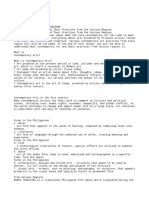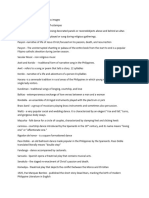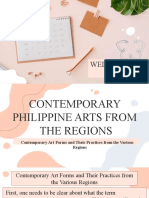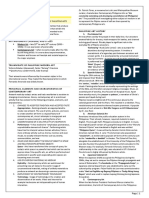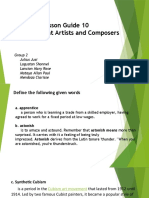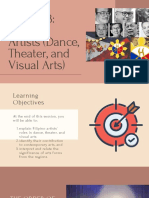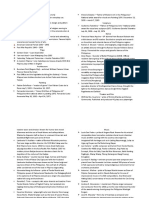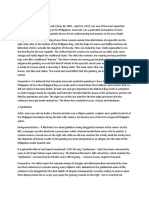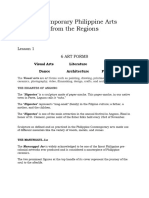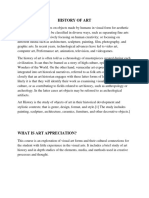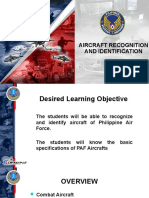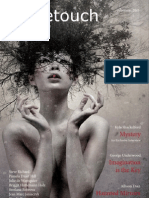Professional Documents
Culture Documents
Conarts 1
Conarts 1
Uploaded by
Danielle Merlin0 ratings0% found this document useful (0 votes)
21 views3 pagesArt is the expression of one's feelings and imagination through creative works like painting, sculpture, or other visual mediums. Contemporary art refers to art produced in the present time, including and developing from postmodern art. Modern art spans from the 1860s to the 1970s and was experimental, while contemporary art is dynamic and challenges boundaries. The major contemporary art forms in the Philippines are music, literature, theater, film, dance, architecture, and visual arts, which are expressed through notable works and artists in each medium.
Original Description:
Original Title
CONARTS 1
Copyright
© © All Rights Reserved
Available Formats
DOCX, PDF, TXT or read online from Scribd
Share this document
Did you find this document useful?
Is this content inappropriate?
Report this DocumentArt is the expression of one's feelings and imagination through creative works like painting, sculpture, or other visual mediums. Contemporary art refers to art produced in the present time, including and developing from postmodern art. Modern art spans from the 1860s to the 1970s and was experimental, while contemporary art is dynamic and challenges boundaries. The major contemporary art forms in the Philippines are music, literature, theater, film, dance, architecture, and visual arts, which are expressed through notable works and artists in each medium.
Copyright:
© All Rights Reserved
Available Formats
Download as DOCX, PDF, TXT or read online from Scribd
Download as docx, pdf, or txt
0 ratings0% found this document useful (0 votes)
21 views3 pagesConarts 1
Conarts 1
Uploaded by
Danielle MerlinArt is the expression of one's feelings and imagination through creative works like painting, sculpture, or other visual mediums. Contemporary art refers to art produced in the present time, including and developing from postmodern art. Modern art spans from the 1860s to the 1970s and was experimental, while contemporary art is dynamic and challenges boundaries. The major contemporary art forms in the Philippines are music, literature, theater, film, dance, architecture, and visual arts, which are expressed through notable works and artists in each medium.
Copyright:
© All Rights Reserved
Available Formats
Download as DOCX, PDF, TXT or read online from Scribd
Download as docx, pdf, or txt
You are on page 1of 3
What is Art?
Art is the expression of one’s feeling through creating something out of their
imagination.
The expression of application of human creative skill and imagination, typically in
a visual form such as painting or sculpture, producing works to be appreciated
primarily for their beauty or emotional power.
What does Contemporary Art mean?
It is a common tendency to describe the present as “modern”. Being modern
means being up to date and technologically advanced. Often, being modern is
equated with being contemporary. Art that is new or current is also referred to as
“modern as opposed to “traditional” or “conservative”. In other words, in everyday parlance,
the terms are interchangeable.
Contemporary art is art produced at the present period in time. Contemporary art
includes, and develops from Post-modern art, which is itself, a successor to Modern art.
“Contemporary” and “Modern” are synonyms but contemporary art and modern
are different.
Modern Art vs. Contemporary Art
Modern Art – Includes artistic work from the periods of roughly 1860s to the 1970s. It is
also where the artists of that time, threw aside the traditions in the spirit of being able to
experiment.
Contemporary Art – is the art of today or artists from the 21st century. It is a dynamic
combination of different ways, mediums, and concepts that challenge traditional
boundaries and defy definition.
The first difference between contemporary and modern art is its historical and
chronological view. The table below proposed by Arts Studies Professors Fajardo and
Flores, titled “Historical Overview of Philippine Art” (2002) shows the summary of the
Philippine Art from Pre-Conquest to the Contemporary. This table includes painting,
sculpture and architecture but as you go on with the lessons, you will learn more forms
of arts such as music, dance, literature, and theater.
The 7 Major Contemporary Art Forms in the Philippines
1. Music
- This is the art form that appeals to the sense of hearing. Music is composed by
combining notes into harmony.
Francisco B. Buencamino Sr. – He was the son of a musically inclined couple. He taught at
the Ateneo de Manila and at the Centro Escolar de Senoritas whose Conservatory of Music
he founded.
Francisco Santiago – known as the “Father of the Kundiman”. His music was Romantic in
style and composed several works such as kundiman, symphonies, piano concertos, and
other music pieces for the piano, violin, and voice.
Antonio Molina – The First National Artist for Music. He is best known for his poignantly
romantic serenade for violin and piano Hatinggabi.
2. Literature
- Is a body of written works. Literature refers to writing considered to be an art form or
any single writing deemed to have artistic or intellectual value, often due to
deployinglanguage in ways that differ from ordinary usage.
Summer Solstice - The Summer Solstice is a short story written by Nick Joaquin. The book
tells the story of a ritual performed by women to call upon the gods to grant fertility.
Fruit Gatherer - is one of most important artist in the history of painting in the Philippines.
He was a portraitist and painter of rural Philippines landscapes. He is popularly known for
his craftsmanship and mastery in the use of light.
Dekada ’70 - The story tells about the Bartolome family’s life during the 1970’s martial law
in the Philippines.
3. Theater
- This is the art form of performance. Dramatic texts are portrayed on stage by actors and
actresses and are enhanced by props, lights, and sounds.
The World Is An Apple - is a play in one act, written by Alberto S. Florentino and directed
by Nick Agudo.It was first presented on television by the Caltex Star Caravan on 24 July
1959 under the direction of Wilfrido Ma. Guerrero.
El Consejo de los Dioses - is a play written in Spanish by Filipino writer and national hero
José Rizal, first published in 1880 in Manila by the Liceo Artistico.
Juan Tamban - This contemporary classic by Philippine Educational Theater Association
(PETA) writer Malou Jacob isespecially adapted by Guelan Valera-Luarca and will be
directed by Charles Yee.
4. Film
- A technological translation of theater. Special effects areutilized to enhance the story
telling.
Dalagang Bukid – is a silent film directed and produced by José Nepomuceno, the Father
of Philippine Cinema.
Himala - The Second Golden Age continued through the '80s, featuring the plight of
migrant workers,the proletariat, as well as the affluent kolehiyalas (college girls)
Heneral Luna - In 1898, Gen. Antonio Luna(John Arcilla) faces resistance from his own
countrymen as he fights for freedom during the Philippine-American War.
5. Dance
- This is the art of the human form. The body is used, mobilized, andchoreographed in a
specific time, form, and space.
Tinikling - Philippine dance which involves two individual performers hitting bamboo
poles, using them to beat,tap, and slide on the ground, in coordination with one or more
dancers who steps over and in between poles.
Cariñosa - is a Philippine dance of colonial era origin from the Maria Clara suite of
Philippine folk dances,where the fan or handkerchief plays an instrumental role as it
places the couple in romance scenario.
Sinulog- Sinulog Festival – is an annual religious and cultural festival in Cebu. The festival
is thought to be the first of the most well-known festivals in the Philippines
6. Architecture
- Are both the process and the product of planning,designing, and constructing buildings
or any other structures.
Lapu-Lapu Shrine - Is a 20-meter bronze statue located in the Mactan Shrine in Punta
Engaño, Mactan Island, Cebu.The statue was erected to honor Rajah Lapu-Lapu, the
native chieftain of Mactan Island who defeated Ferdinan Magellan during historic battle
of Mactan in 1521.
Rizal Monument - is considered by many as the most popular, most visited and most
photographed monumentin the Philippines. It housed the remains of Jose Rizal, a
Filipino nationalist, novelist, poet, journalist, ophthalmologist,and a national hero.
Leyte Landing Monument - MacArthur Landing Memorial Park in Palo beach was the site
where the Allied Forces led by General Douglas MacArthur landed in Leyte on October
20, 1944. The monument also reminds us thefulfillment of MacArthur’s iconic word and
promise “I shall return”.
7. Visual Arts
- Artwork, such as painting, photography, or sculpture that appeals primarily to the visual
sense and typically exists in permanent form.
Blood Compact - is one of the most important historical events in the annals of Philippine
History, not only of Tagbilaran City and the whole Bohol province. The event
was even immortalized in canvass by the famous Filipino painter Juan Luna and his work
was considered as one of his masterpieces.
Francisco Guerrero - The woman’s name is Oyog. She is a community leader, dancer and
teacher with the T’boli people
Black Nazarene - The Black Nazarene is a life-sized statue of Jesus Christ originally from
Mexico andbrought to the Philippines in 1606.
You might also like
- Women of The Academie JulianDocument10 pagesWomen of The Academie Julianamatoke050% (2)
- Contemporary ArtDocument5 pagesContemporary ArtGlorelie Arnoco - ABM 3No ratings yet
- Art App Group 1 ReportingDocument35 pagesArt App Group 1 ReportingMaicaNo ratings yet
- Cpar L1 PDFDocument4 pagesCpar L1 PDFBerna Dette ZoneNo ratings yet
- Cpar ReviewerDocument5 pagesCpar ReviewerrichtellegNo ratings yet
- Cpar PPT Week 4 5Document39 pagesCpar PPT Week 4 5ninaericaricafortNo ratings yet
- Contemporary Arts in The PhilippinesDocument25 pagesContemporary Arts in The Philippinesshena mae acotNo ratings yet
- Cpar L1Document19 pagesCpar L1Grace Ann Barasi0% (1)
- Local Media4093840439205180354Document10 pagesLocal Media4093840439205180354Winsear VardeNo ratings yet
- OutlineDocument14 pagesOutlineKyla Gabrielle De GuzmanNo ratings yet
- CPARDocument4 pagesCPARPrincess NacisNo ratings yet
- Contemporary ArtsDocument3 pagesContemporary ArtsMarinelle R. EumagueNo ratings yet
- Cpar w2 HODocument2 pagesCpar w2 HOmaricar jodelah uyegNo ratings yet
- Final, ArtworksDocument3 pagesFinal, ArtworksArsela MaeNo ratings yet
- Activity Sheet No. 4-5 (MODULE8-10)Document7 pagesActivity Sheet No. 4-5 (MODULE8-10)Nellie DucusinNo ratings yet
- Various Contemporary Art Forms andDocument62 pagesVarious Contemporary Art Forms andRoselyn L. Dela CruzNo ratings yet
- reviewer ノಠ益ಠノ彡Document25 pagesreviewer ノಠ益ಠノ彡t4 we5 werg 5No ratings yet
- Various Contemporary Art Forms and Their Practices From The Various RegionsDocument55 pagesVarious Contemporary Art Forms and Their Practices From The Various RegionsRoselyn L. Dela CruzNo ratings yet
- PaintingsDocument2 pagesPaintingsAmaris SoleilNo ratings yet
- Lesson 5Document44 pagesLesson 5Welson M. BersanoNo ratings yet
- Art in The PastDocument6 pagesArt in The PastChibuzo Nelia NwaogboNo ratings yet
- Contemporary Philippine Arts From The Regions: Lessson 1Document35 pagesContemporary Philippine Arts From The Regions: Lessson 1gillianeNo ratings yet
- Lyceum of The Phlippines University ETEEAP General Education Requirement For HumanitiesDocument7 pagesLyceum of The Phlippines University ETEEAP General Education Requirement For HumanitiesCristopher Romero DanlogNo ratings yet
- Carts Lesson 1Document33 pagesCarts Lesson 1John Elton TangpuzNo ratings yet
- Lesson Guide 10 Pinoy Great Artists and ComposersDocument31 pagesLesson Guide 10 Pinoy Great Artists and ComposersClarisse MendozaNo ratings yet
- Local Artists and Their Piece of ArtsDocument25 pagesLocal Artists and Their Piece of ArtsNikki PalicpicNo ratings yet
- Enhance Lesson On (Lesson 2) Contemporary Art Forms and Practices From The RegionsDocument10 pagesEnhance Lesson On (Lesson 2) Contemporary Art Forms and Practices From The RegionsJVNo ratings yet
- National ArtistDocument2 pagesNational ArtistLea SantueleNo ratings yet
- What Is ArtDocument45 pagesWhat Is ArtAlfred NodadoNo ratings yet
- National Artist: in JapanDocument8 pagesNational Artist: in JapanQuartz KrystalNo ratings yet
- Philippine Contemporary Arts: Apply What You Have Learned: Task 3 (Scrapbook)Document11 pagesPhilippine Contemporary Arts: Apply What You Have Learned: Task 3 (Scrapbook)Andre SaritaNo ratings yet
- Cpar 4Document84 pagesCpar 4cannorlanes2020No ratings yet
- Handout 1Document5 pagesHandout 1Bujorge BuboyNo ratings yet
- The National Artists of The Philippines Painting Contemporary Period ThemesDocument21 pagesThe National Artists of The Philippines Painting Contemporary Period Themestravis slothNo ratings yet
- Visual Arts in The Philippines (Learning Material)Document11 pagesVisual Arts in The Philippines (Learning Material)Migz ManalotoNo ratings yet
- Cpar Study GuideDocument10 pagesCpar Study GuideChelsey RotorNo ratings yet
- Contemporary Arts ReviewerDocument3 pagesContemporary Arts ReviewermilimguinoNo ratings yet
- Contemporary ArtDocument27 pagesContemporary ArtKylee NathanielNo ratings yet
- Copy of National Artists (Dance, Theater, and Visual Arts)Document26 pagesCopy of National Artists (Dance, Theater, and Visual Arts)Cherry Mae PanongNo ratings yet
- Cpar Reviewer Q1 Balungaya - MargieDocument12 pagesCpar Reviewer Q1 Balungaya - MargieChris john AlfilerNo ratings yet
- Arts ReviewDocument2 pagesArts ReviewJohnbrix AcuñaNo ratings yet
- Seven Arts Recognized by NccaDocument5 pagesSeven Arts Recognized by NccaApril Kitz S. SuanNo ratings yet
- ArtDocument4 pagesArtRicoNo ratings yet
- ArtworksDocument3 pagesArtworksArsela MaeNo ratings yet
- Module 11 and 12 CparDocument42 pagesModule 11 and 12 CparYuniz AgásaytNo ratings yet
- Contemporary Arts EditDocument10 pagesContemporary Arts EditRikkard AmbroseNo ratings yet
- Filipino ArtistsDocument50 pagesFilipino ArtistsAlyssa CesnerosNo ratings yet
- Various Contemporary Art Forms and Their Practices From The Various RegionsDocument37 pagesVarious Contemporary Art Forms and Their Practices From The Various RegionsRoselyn L. Dela Cruz100% (1)
- Contemporary ArtsDocument7 pagesContemporary ArtsJericho CarillasNo ratings yet
- Learning Activity Sheet Order of National ArtistsDocument9 pagesLearning Activity Sheet Order of National ArtistsFaith MirandillaNo ratings yet
- Learning Plan 1 (Ligutan)Document10 pagesLearning Plan 1 (Ligutan)lovj melNo ratings yet
- ARTS in AMERICAN-JAPANESE PeriodsDocument7 pagesARTS in AMERICAN-JAPANESE PeriodsEahrielle Andhrew PlataNo ratings yet
- Every Artist Plays A Different and Necessary Part in Contributing To The Overall Health, Development, and Well-Being of Our SocietyDocument5 pagesEvery Artist Plays A Different and Necessary Part in Contributing To The Overall Health, Development, and Well-Being of Our SocietySharmaine SengsonNo ratings yet
- Contemporary Philippine Arts From The Regions: Lesson 1 6 Art FormsDocument14 pagesContemporary Philippine Arts From The Regions: Lesson 1 6 Art FormsJarrah Romaine Alcantara EchaureNo ratings yet
- CPAR Reviewer UpdatedDocument23 pagesCPAR Reviewer UpdatedReyvelyn ArcipeNo ratings yet
- History of ArtDocument4 pagesHistory of ArtWilliam Vincent SoriaNo ratings yet
- Contemporary Arts in Visayas: (Cebuano)Document21 pagesContemporary Arts in Visayas: (Cebuano)Mac ZacharyNo ratings yet
- Reviewer 2ND QTR CparDocument4 pagesReviewer 2ND QTR CparAmalia OlorocisimoNo ratings yet
- What Is Philippine ArtDocument4 pagesWhat Is Philippine ArtKean NueNo ratings yet
- G 12 ReviewDocument9 pagesG 12 Reviewlawrence christian dragidoNo ratings yet
- 3.1 Aircraft in General EditedDocument26 pages3.1 Aircraft in General EditedDanielle MerlinNo ratings yet
- ROTC Prelims PDFDocument207 pagesROTC Prelims PDFDanielle MerlinNo ratings yet
- NSTP 1 Quiz BeeDocument61 pagesNSTP 1 Quiz BeeDanielle MerlinNo ratings yet
- SPCF ROTC Orientation 2nd SemDocument61 pagesSPCF ROTC Orientation 2nd SemDanielle MerlinNo ratings yet
- 3.2 Aircraft Recognition and IdentiificationDocument54 pages3.2 Aircraft Recognition and IdentiificationDanielle MerlinNo ratings yet
- CJS123Document31 pagesCJS123Danielle MerlinNo ratings yet
- Conarts 3Document5 pagesConarts 3Danielle MerlinNo ratings yet
- 3.1 Aircraft in General EditedDocument26 pages3.1 Aircraft in General EditedDanielle MerlinNo ratings yet
- 3.2 Aircraft Recognition and IdentiificationDocument54 pages3.2 Aircraft Recognition and IdentiificationDanielle MerlinNo ratings yet
- Activity1 - Matter (Atom, Molecule and Compound)Document3 pagesActivity1 - Matter (Atom, Molecule and Compound)Danielle MerlinNo ratings yet
- Conarts 2Document4 pagesConarts 2Danielle MerlinNo ratings yet
- Activity-2 Intro To Physical ScienceDocument3 pagesActivity-2 Intro To Physical ScienceDanielle MerlinNo ratings yet
- World Religion Midterm Test ReviewerDocument2 pagesWorld Religion Midterm Test ReviewerDanielle MerlinNo ratings yet
- Critique TemplateDocument3 pagesCritique TemplateDanielle MerlinNo ratings yet
- Logic CompleteDocument26 pagesLogic CompleteDanielle MerlinNo ratings yet
- WednesdayDocument20 pagesWednesdayDanielle MerlinNo ratings yet
- CST Midterm LessonsDocument7 pagesCST Midterm LessonsDanielle MerlinNo ratings yet
- PPT5 Atomic-StructureFINALDocument34 pagesPPT5 Atomic-StructureFINALDanielle MerlinNo ratings yet
- CPC - FordamidtermsDocument22 pagesCPC - FordamidtermsDanielle MerlinNo ratings yet
- What Is The Role of Each Concept To Philippine Popular CultureDocument2 pagesWhat Is The Role of Each Concept To Philippine Popular CultureDanielle MerlinNo ratings yet
- CPC 9 (Module Unit 5 Activity 1 Business Letter)Document3 pagesCPC 9 (Module Unit 5 Activity 1 Business Letter)Danielle MerlinNo ratings yet
- CULACTDocument10 pagesCULACTDanielle MerlinNo ratings yet
- Fundamental Concepts of Law, Crime, Criminology, Criminal Justice, Deviance and DelinquencyDocument21 pagesFundamental Concepts of Law, Crime, Criminology, Criminal Justice, Deviance and DelinquencyDanielle MerlinNo ratings yet
- NCP Risk For Impaired AttachmentDocument1 pageNCP Risk For Impaired AttachmentDanielle MerlinNo ratings yet
- CRIM 1 Finals ReviewerDocument52 pagesCRIM 1 Finals ReviewerDanielle MerlinNo ratings yet
- Activity 8 Lymphatic and Heart SystemDocument5 pagesActivity 8 Lymphatic and Heart SystemDanielle MerlinNo ratings yet
- Pop Culture and The Rise of Social Media in The Philippines: An OverviewDocument2 pagesPop Culture and The Rise of Social Media in The Philippines: An OverviewDanielle MerlinNo ratings yet
- Ged108 Reviewer 1ST Term Module 1Document7 pagesGed108 Reviewer 1ST Term Module 1RJ BorlonganNo ratings yet
- Introduction To Unit and RomanticismDocument7 pagesIntroduction To Unit and RomanticismDuaa Saqri RamahiNo ratings yet
- Arts - 8 - Q1 - WT2Document6 pagesArts - 8 - Q1 - WT2Jennifer Faji-MangaNo ratings yet
- 2013 Fredrix Domestic Order FormDocument12 pages2013 Fredrix Domestic Order FormMark DraperNo ratings yet
- Aesthetics of Electroacoustic Music PDFDocument5 pagesAesthetics of Electroacoustic Music PDFRohit GuptaNo ratings yet
- Musetouch Issue 7Document202 pagesMusetouch Issue 7M Inês100% (3)
- Animales Del Zodiaco 2Document39 pagesAnimales Del Zodiaco 2Catalina González88% (8)
- Your SBA Rubric and GuidelinesDocument3 pagesYour SBA Rubric and Guidelinesdaniel whitelyNo ratings yet
- Silent Night, Sheet Music For Violin & PianoDocument4 pagesSilent Night, Sheet Music For Violin & PianoViktor Dick100% (3)
- Lesson 12Document8 pagesLesson 12Mary Rose JorzaNo ratings yet
- Portfolio Example For Digital Media 1Document12 pagesPortfolio Example For Digital Media 1Kyle Meeks100% (1)
- The ScreamDocument4 pagesThe Screamkerarox194No ratings yet
- English 9 - Unit 1 - Lesson 2 - Features of Anglo American LiteratureDocument17 pagesEnglish 9 - Unit 1 - Lesson 2 - Features of Anglo American LiteratureLance Andrew S. Gacayan0% (1)
- Between East and West Reconsidering MikhDocument15 pagesBetween East and West Reconsidering MikhVera Marques AlvesNo ratings yet
- Fashion and AccessoriesDocument3 pagesFashion and AccessoriesMohit YadavNo ratings yet
- Department of Education: Word SearchDocument16 pagesDepartment of Education: Word SearchBuenaventura MataNo ratings yet
- Alexander Calder-Inspired Wire Sculpture Lesson Plan October 2009 PDFDocument14 pagesAlexander Calder-Inspired Wire Sculpture Lesson Plan October 2009 PDFAnabel LiévanoNo ratings yet
- Art Appreciation LectureDocument6 pagesArt Appreciation LectureMariz TrajanoNo ratings yet
- 2nd Illustration EssayDocument4 pages2nd Illustration EssayFaye CheeNo ratings yet
- Creative WritingDocument2 pagesCreative WritingChristian EaNo ratings yet
- Primer - The Development of Art Galleries (PHL)Document33 pagesPrimer - The Development of Art Galleries (PHL)markNo ratings yet
- Arts of East Asia - Handout1Document4 pagesArts of East Asia - Handout1Elay SarandiNo ratings yet
- The Renaissance ArchitectureDocument18 pagesThe Renaissance ArchitectureRazvan BataiosuNo ratings yet
- The 100 Katao 100 Taka Exhibition Project: An Exercise and Example of Traditional-Contemporary EngagementDocument18 pagesThe 100 Katao 100 Taka Exhibition Project: An Exercise and Example of Traditional-Contemporary Engagementநெல்லி டேவிஸ்No ratings yet
- Identity Crisis: Experimental Film and Artistic Expansion : Jonathan WalleyDocument28 pagesIdentity Crisis: Experimental Film and Artistic Expansion : Jonathan WalleyantivahoNo ratings yet
- Lei Spain 0318Document80 pagesLei Spain 0318JuanRodriguez100% (1)
- From Pomanders To Perfumers, A Brief History of British Perfume - STORIES ParfumsDocument7 pagesFrom Pomanders To Perfumers, A Brief History of British Perfume - STORIES ParfumsCNo ratings yet
- TAEA Newsletter Spring 2011Document12 pagesTAEA Newsletter Spring 201110AEANo ratings yet



